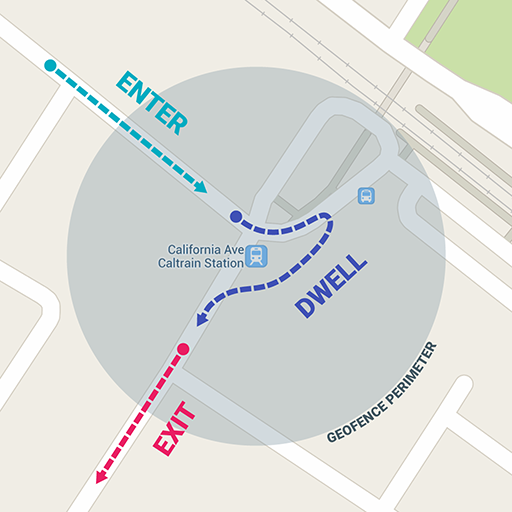创建和监视地理围栏
编写:penkzhou - 原文:http://developer.android.com/training/location/geofencing.html
地理围栏将用户当前位置感知和附件地点特征感知相结合。为了标示一个感兴趣的位置,我们需要指定这个位置的经纬度。为了调整位置的邻近度,需要添加一个半径。经纬度和半径定义一个地理围栏,即在感兴趣的位置创建一个圆形区域或者围栏。
我们可以有多个活动的地理围栏(限制是一个设备用户100个)。对于每个地理围栏,我们可以让 Location Services 发出进入和离开事件,或者我们可以在触发一个事件之前,指定在某个地理围栏区域等待一段时间或者停留。通过指定一个以毫秒为单位的截止时间,我们可以限制任何一个地理围栏的持续时间。当地理围栏失效后,Location Services 会自动删除这个地理围栏。

这节课介绍如何添加和删除地理围栏,和用 IntentService 监听地理位置变化。
设置地理围栏监视
请求地理围栏监视的第一步就是设置必要的权限。在使用地理围栏时,我们必须设置 ACCESS_FINE_LOCATION 权限。在应用的 manifest 文件中添加如下子节点即可:
<uses-permission android:name="android.permission.ACCESS_FINE_LOCATION"/>
如果想要用 IntentService 监听地理位置变化,那么还需要添加一个节点来指定服务名字。这个节点必须是
<applicationandroid:allowBackup="true">...<service android:name=".GeofenceTransitionsIntentService"/><application/>
为了访问位置 API,我们需要创建一个 Google Play services API client 的实例。想要学习如何连接 client,请见连接Google Play Services。
创建和添加地理围栏
我们的应用需要用位置 API 的 builder 类来创建地理围栏,用 convenience 类来添加地理围栏。另外,我们可以定义一个 PendingIntent(将在这节课介绍)来处理当地理位置发生迁移时,Location Services 发出的 intent。
创建地理围栏对象
首先,用 Geofence.Builder 创建一个地理围栏,设置想要的半径,持续时间,和地理围栏迁移的类型。例如,填充一个叫做 mGeofenceList 的 list 对象:
mGeofenceList.add(new Geofence.Builder()// Set the request ID of the geofence. This is a string to identify this// geofence..setRequestId(entry.getKey()).setCircularRegion(entry.getValue().latitude,entry.getValue().longitude,Constants.GEOFENCE_RADIUS_IN_METERS).setExpirationDuration(Constants.GEOFENCE_EXPIRATION_IN_MILLISECONDS).setTransitionTypes(Geofence.GEOFENCE_TRANSITION_ENTER |Geofence.GEOFENCE_TRANSITION_EXIT).build());
这个例子从一个固定的文件中获取数据。在实际情况下,应用可能会根据用户的位置动态地创建地理围栏。
指定地理围栏和初始化触发器
下面的代码用到 GeofencingRequest 类。该类嵌套了 GeofencingRequestBuilder 类来需要监视的地理围栏和设置如何触发地理围栏事件:
private GeofencingRequest getGeofencingRequest() {GeofencingRequest.Builder builder = new GeofencingRequest.Builder();builder.setInitialTrigger(GeofencingRequest.INITIAL_TRIGGER_ENTER);builder.addGeofences(mGeofenceList);return builder.build();}
这个例子介绍了两个地理围栏触发器。当设备进入一个地理围栏时, GEOFENCE_TRANSITION_ENTER 转移会触发。当设备离开一个地理围栏时, GEOFENCE_TRANSITION_EXIT 转移会触发。如果设备已经在地理围栏里面,那么指定 INITIAL_TRIGGER_ENTER 来通知位置服务触发 GEOFENCE_TRANSITION_ENTER。
在很多情况下,使用 INITIAL_TRIGGER_DWELL 可能会更好。仅仅当由于到达地理围栏中已定义好的持续时间,而导致用户停止时,INITIAL_TRIGGER_DWELL 才会触发事件。这个方法可以减少当设备短暂地进入和离开地理围栏时,由大量的通知造成的“垃圾警告信息”。另一种获取最好的地理围栏结果的策略是设置最小半径为100米。这有助于估计典型的 Wifi 网络的位置精确度,也有利于降低设备的功耗。
为地理围栏转移定义Intent
从 Location Services 发送来的Intent能够触发各种应用内的动作,但是不能用它来打开一个 Activity 或者 Fragment,这是因为应用内的组件只能在响应用户动作时才可见。大多数情况下,处理这一类 Intent 最好使用 IntentService。一个 IntentService 可以推送一个通知,可以进行长时间的后台作业,可以将 intent 发送给其他的 services ,还可以发送一个广播 intent。下面的代码展示了如何定义一个 PendingIntent 来启动一个 IntentService:
public class MainActivity extends FragmentActivity {...private PendingIntent getGeofencePendingIntent() {// Reuse the PendingIntent if we already have it.if (mGeofencePendingIntent != null) {return mGeofencePendingIntent;}Intent intent = new Intent(this, GeofenceTransitionsIntentService.class);// We use FLAG_UPDATE_CURRENT so that we get the same pending intent back when// calling addGeofences() and removeGeofences().return PendingIntent.getService(this, 0, intent, PendingIntent.FLAG_UPDATE_CURRENT);}
添加地理围栏
使用 GeoencingApi.addGeofences() 方法来添加地理围栏。为该方法提供 Google API client,GeofencingRequest 对象和 PendingIntent。下面的代码,在 onResult()) 中处理结果,假设主 activity 实现 ResultCallback。
public class MainActivity extends FragmentActivity {...LocationServices.GeofencingApi.addGeofences(mGoogleApiClient,getGeofencingRequest(),getGeofencePendingIntent()).setResultCallback(this);
处理地理围栏转移
当 Location Services 探测到用户进入或者离开一个地理围栏,它会发送一个包含在 PendingIntent 的 Intent,这个 PendingIntent 就是在添加地理围栏时被我们包括在请求当中。这个 Intent 被一个类似 GeofenceTransitionsIntentService 的 service 接收,这个 service 从 intent 得到地理围栏事件,决定地理围栏转移的类型,和决定触发哪个已定义的地理围栏。然后它会发出一个通知。
下面的代码介绍了如何定义一个 IntentService。这个 IntentService 在地理围栏转移出现时,会推送一个通知。当用户点击这个通知,那么应用的主 activity 会出现:
public class GeofenceTransitionsIntentService extends IntentService {...protected void onHandleIntent(Intent intent) {GeofencingEvent geofencingEvent = GeofencingEvent.fromIntent(intent);if (geofencingEvent.hasError()) {String errorMessage = GeofenceErrorMessages.getErrorString(this,geofencingEvent.getErrorCode());Log.e(TAG, errorMessage);return;}// Get the transition type.int geofenceTransition = geofencingEvent.getGeofenceTransition();// Test that the reported transition was of interest.if (geofenceTransition == Geofence.GEOFENCE_TRANSITION_ENTER ||geofenceTransition == Geofence.GEOFENCE_TRANSITION_EXIT) {// Get the geofences that were triggered. A single event can trigger// multiple geofences.List triggeringGeofences = geofencingEvent.getTriggeringGeofences();// Get the transition details as a String.String geofenceTransitionDetails = getGeofenceTransitionDetails(this,geofenceTransition,triggeringGeofences);// Send notification and log the transition details.sendNotification(geofenceTransitionDetails);Log.i(TAG, geofenceTransitionDetails);} else {// Log the error.Log.e(TAG, getString(R.string.geofence_transition_invalid_type,geofenceTransition));}}
在通过 PendingIntent 检测转移事件之后,这个 IntentService 获取地理围栏转移类型和测试一个事件是不是应用用来触发通知的 —— 要么是 GEOFENCE_TRANSITION_ENTER,要么是 GEOFENCE_TRANSITION_EXIT。然后,这个 service 会发出一个通知并且记录转移的详细信息。
停止地理围栏监视
当不再需要监视地理围栏或者想要节省设备的电池电量和 CPU 周期时,需要停止地理围栏监视。我们可以在用于添加和删除地理围栏的主 activity 里停止地理围栏监视;删除地理围栏会导致它马上停止。API 要么通过 request IDs,要么通过删除与指定 PendingIntent 相关的地理围栏来删除地理围栏。
下面的代码通过 PendingIntent 删除地理围栏,当设备进入或者离开之前已经添加的地理围栏时,停止所有通知:
LocationServices.GeofencingApi.removeGeofences(mGoogleApiClient,// This is the same pending intent that was used in addGeofences().getGeofencePendingIntent()).setResultCallback(this); // Result processed in onResult().}
你可以将地理围栏同其他位置感知的特性结合起来,比如周期性的位置更新。像要了解更多的信息,请看本章的其它课程。

